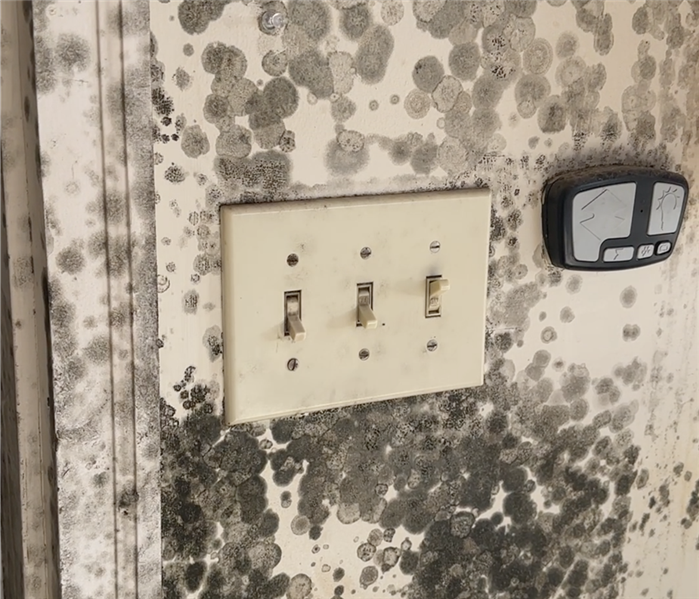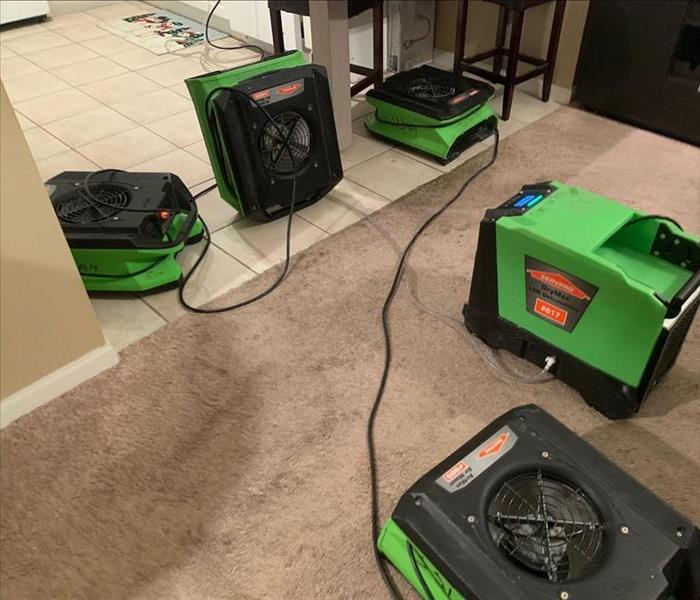How do you get rid of mold in a shower?
11/13/2024 (Permalink)
 While DIY methods can help with minor mold issues, severe or recurring mold problems may require professional intervention.
While DIY methods can help with minor mold issues, severe or recurring mold problems may require professional intervention.
Mold in your shower is a common problem, especially in high-moisture areas like Lake Arlington. Knowing how to get rid of mold in a shower is crucial to maintaining a clean and safe home. As experts in water damage and mold remediation, SERVPRO of Lake Arlington provides insight into the best methods for removing mold from your shower and preventing it from coming back.
What Causes Mold to Grow in Showers?
Mold thrives in damp, humid environments, which makes your shower the perfect breeding ground. The combination of warm temperatures, soap scum, and moisture creates the ideal conditions for mold growth, especially in the grout and caulking of your shower. To effectively remove mold, you need to understand its root causes and address them properly.
Best Methods for Removing Mold from Your Shower
There are several effective DIY methods you can use to tackle mold in your shower. Here’s a step-by-step approach:
- Scrub with Baking Soda and Vinegar: Start by mixing baking soda and white vinegar to create a paste. Apply this mixture to the moldy areas, especially in the grout and caulking. Let it sit for 10-15 minutes before scrubbing with a brush. This method is highly effective because baking soda is abrasive, and vinegar is a natural mold-fighting agent.
- Use Bleach: A solution of one part bleach to ten parts water can also help remove mold. Apply the solution to the affected area and let it sit for 15 minutes before rinsing. Remember to use proper ventilation when working with bleach.
- Apply a Commercial Mold Remover: There are plenty of mold-removal sprays available that are specifically designed for showers. Follow the manufacturer’s instructions for the best results.
- Reseal Your Grout and Caulking: After cleaning, consider resealing your shower’s grout and caulking to prevent mold from returning. Silicone-based sealants are especially effective in preventing moisture buildup.
Mold Prevention Tips
Did you know that the average household bathroom has a humidity level of 70% after a shower? According to the U.S. Environmental Protection Agency (EPA), keeping humidity levels below 60% is key to preventing mold growth. Here are some preventive measures you can take:
- Use a bathroom exhaust fan to reduce moisture.
- Wipe down your shower walls after each use.
- Leave your shower door or curtain open to allow air circulation.
- Clean and reseal grout and caulking regularly.
Trust the Experts at SERVPRO of Lake Arlington
While DIY methods can help with minor mold issues, severe or recurring mold problems may require professional intervention. At SERVPRO of Lake Arlington, we offer expert mold remediation services to ensure your shower stays mold-free for good. Whether you need advice or a full-scale mold removal, our experienced team is ready to help.
Understanding the Spread of Mold: How It Happens and What You Can Do
7/10/2024 (Permalink)
 We explore the various ways mold can spread within your home and provide tips for preventing its proliferation.
We explore the various ways mold can spread within your home and provide tips for preventing its proliferation.
Mold is a common household problem that can spread quickly if left unchecked. Understanding how mold spreads is crucial for effective prevention and remediation. In this blog post, we'll explore the various ways mold can spread within your home and provide tips for preventing its proliferation.
Through Airborne Spores
Mold spreads primarily through airborne spores. These microscopic particles are released into the air when mold colonies are disturbed, such as during cleaning or renovation activities. Once airborne, mold spores can travel through the air currents and settle on surfaces throughout your home, where they can germinate and proliferate under the right conditions.
Through Contact with Contaminated Surfaces
Mold can also spread through direct contact with contaminated surfaces. When mold spores land on surfaces such as walls, ceilings, furniture, or household items, they can attach and begin to grow if moisture and organic material are present. Touching or disturbing mold-contaminated surfaces can dislodge spores and spread them to other areas of your home.
Through HVAC Systems
HVAC (Heating, Ventilation, and Air Conditioning) systems can contribute to the spread of mold throughout your home. Mold spores can enter HVAC systems through intake vents or leaks in ductwork, where they can accumulate and spread through the air ducts to other rooms. Poorly maintained HVAC systems with inadequate filtration can exacerbate mold spread.
Through Water Intrusion
Water intrusion is a common cause of mold growth and spread within homes. Leaks from plumbing fixtures, roof leaks, floods, or high humidity levels can introduce moisture into your home, creating ideal conditions for mold growth. Mold can spread rapidly in damp environments, moving from the initial source of moisture to adjacent areas.
Through Personal Belongings
Mold can also spread through personal belongings such as clothing, furniture, and household items. Mold spores can attach to these items and be transported from one location to another, spreading mold throughout your home. Contaminated belongings should be properly cleaned and disinfected to prevent further spread of mold.
Tips for Preventing Mold Spread
Maintain Proper Indoor Humidity:
Keep indoor humidity levels between 30% and 50% to inhibit mold growth and spread. Use dehumidifiers in damp areas and ensure adequate ventilation throughout your home.
Address Water Intrusion Promptly:
Promptly repair any water leaks, plumbing issues, or water damage to prevent mold growth and spread. Thoroughly dry affected areas within 24-48 hours to prevent mold from taking hold.
Clean and Disinfect Contaminated Surfaces:
Regularly clean and disinfect surfaces prone to mold growth, such as bathrooms, kitchens, and basements. Use mold-inhibiting cleaners and proper ventilation to prevent mold from spreading.
Maintain HVAC Systems:
Regularly inspect and maintain your HVAC system to prevent mold buildup in air ducts and components. Change air filters regularly and ensure proper ventilation to minimize mold spread through HVAC systems.
Mold can spread quickly and easily within your home, posing a threat to both your property and your health. By understanding the various ways mold spreads and implementing preventive measures such as maintaining proper humidity levels, addressing water intrusion promptly, cleaning and disinfecting contaminated surfaces, and maintaining HVAC systems, you can effectively prevent mold spread and maintain a healthy indoor environment. If you suspect mold growth or need assistance with mold remediation, contact a professional restoration company like SERVPRO® for expert assessment and remediation services.
Conditions in Lake Arlington Might Be Right For Mold
2/1/2021 (Permalink)
It’s estimated that more than 1 million types of mold exist, yet less than 10 percent have actually been named. This means mold is very common in both indoor and outdoor environments. While mold and humans can sometimes co-exist without issue, certain species of mold can cause health effects for some people.
If the right conditions exist, mold will grow. Those conditions include:
- Water - Different mold types require varying amounts of liquid before growth begins.
- Temperature - Normal indoor temperatures will promote mold growth.
- Time - Initial mold colonizers can take hold within one day after being exposed to an adequate water supply.
Mold growth can occur in any home, so it’s important to keep an eye out for situations that might promote mold activity. Roof/chimney leaks, wet basements, or condensation from ducts that dampen surrounding insulation are just a few examples of issues that make a house a prime target for mold growth.
If you suspect mold in your home, call SERVPRO of Lake Arlington to assess the situation. We have the knowledge, tools, and track record to effectively remediate mold in your home or business.
If you suspect mold, call us today at 817-460-7766
What to Do:
- Stay out of affected areas.
- Turn off the HVAC system and fans.
- Contact SERVPRO of Lake Arlington for mold remediation services.
Does Your Lake Arlington Home Have Mold Problems?
1/27/2021 (Permalink)
Microscopic mold spores naturally occur almost everywhere, both outdoors and indoors. This makes it impossible to remove all mold from a home or business. Therefore, mold remediation reduces the mold spore count back to its natural or baseline level. Some restoration businesses advertise mold removal and even guarantee to remove all mold, which is a fallacy. Consider the following mold facts:
- Mold is present almost everywhere, indoors and outdoors.
- Mold spores are microscopic and float along in the air and may enter your home through windows, doors, or AC/heating systems or even hitch a ride indoors on your clothing or a pet.
- Mold spores thrive on moisture. Mold spores can quickly grow into colonies when exposed to water. These colonies may produce allergens and irritants.
- Before mold remediation can begin, any sources of water or moisture must be addressed. Otherwise, the mold may return.
- Mold often produces a strong, musty odor and can lead you to possible mold problem areas.
- Even higher-than-normal indoor humidity can support mold growth. Keep indoor humidity below 45 percent.
If your home or business has a mold problem, we can inspect and assess your property and use our specialized training, equipment, and expertise to remediate your mold infestation.
If You See Signs of Mold, Call Us Today- 817-460-7766
 While DIY methods can help with minor mold issues, severe or recurring mold problems may require professional intervention.
While DIY methods can help with minor mold issues, severe or recurring mold problems may require professional intervention.




 24/7 Emergency Service
24/7 Emergency Service
